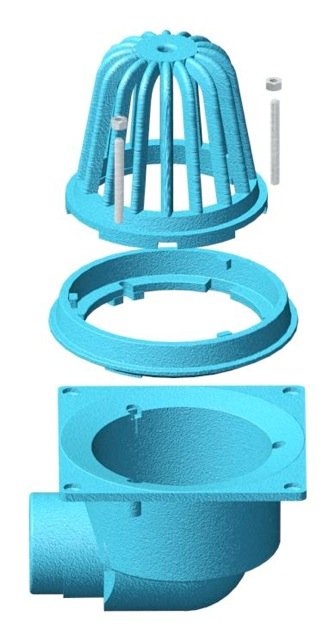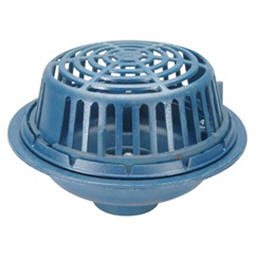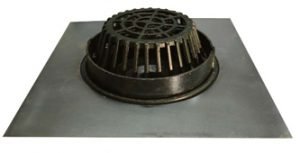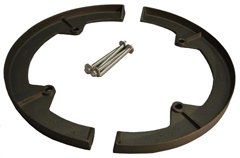
A proper roof drainage system is vital for any building. While roof applications and designs vary from one building to the next, the purpose of the drain does not. Whether you live in a very wet climate or a dry one, your roof is bound to experience rain and other weather elements that, without a working roof drain, will cause damage to the structure of the building. This includes the growth of stubborn mold, deterioration of walls and foundation, and leaks that affect the interior of your home or business.
The modern roof drain is designed to drain off rain water in the most effective manner possible while maintaining an aesthetic appeal because in many instances it is placed in full view of the public.
When selecting a new installation drain, there are four main materials from which to choose:
cast iron, copper, plastic and aluminum. Cast iron is by far the most popular, as evidenced by the size and scope of cast iron manufacturers such as
Josam, Jay R Smith, Zurn, Frank Pattern, Wade, and Watt.
Copper is also popular; as it ages it produces a nice patina effect and isn’t affected by the elements. Parapet and scupper drains are two examples of popular copper drains. Clamping rings are specified for copper drains when using with single ply. Manufacturers of copper drains include
Marathon, Thunderbird and LSP.
Plastic (ABS) drains are an economical option that is easily flashed from Built Up Roofing (BUR) to Single Ply applications.

When determining the type of drain, the size of drains, and the total number of drains needed for your particular application, drain accessories are often used for installation purposes. In terms of popularity, the most common drain is a cast iron assembly consisting of a body (sump), a combination membrane flashing clamp/gravel guard, and a dome strainer.
Some of the most popular drain accessories are water dams (overflow), under-deck clamps, and sump receivers.
Exterior water dams are used to keep debris away from the dome until overflow action begins. Most water dams are 2” high. Outer water dams are more popular than inner water dams, as they keep debris from clogging the dome.
Under-deck clamps are recommended to provide a secure, long lasting installation of the roof drain on all but poured-in-place installations. Roof drains must be firmly secured to the roof with an under-deck clamp, otherwise, due to snow loads, rain loads and regular expansion and contraction, the drain will work in and out of the roofing, causing roofing membranes to flex and fail. Brittle asphalt will crack and leaks will occur.
A
sump receiver, also referred to as a
bearing pan, is used when exact location of the drain can’t be determined or when instances of opening the roof can not be precisely cut. It distributes the weight and securely cradles the drain in the roof deck.


The sump receiver is a square metal plate with recessed center opening to accept the drain body flange. This eliminates the puddle of water surrounding many roof drain installations due to the flange resting on top of a circular hole cut in the roof. A poor installation occurs when a circular hole has been cut in the roof that ends up off center of the leader pipe. The result is usually a crooked or off-set leader. The square sump receiver allows the hole to be cut oversize and square permitting the drain to be shifted and centered over the pipe. The illustration shows the probable result of not using a sump receiver. The drain body is improperly seated on the deck, causing roofing felts and other roofing materials to create a dam-like effect around the drain, resulting in a puddle in the vicinity of the drain. This problem can always be eliminated with a sump receiver.
 A proper roof drainage system is vital for any building. While roof applications and designs vary from one building to the next, the purpose of the drain does not. Whether you live in a very wet climate or a dry one, your roof is bound to experience rain and other weather elements that, without a working roof drain, will cause damage to the structure of the building. This includes the growth of stubborn mold, deterioration of walls and foundation, and leaks that affect the interior of your home or business.
The modern roof drain is designed to drain off rain water in the most effective manner possible while maintaining an aesthetic appeal because in many instances it is placed in full view of the public.
When selecting a new installation drain, there are four main materials from which to choose: cast iron, copper, plastic and aluminum. Cast iron is by far the most popular, as evidenced by the size and scope of cast iron manufacturers such as Josam, Jay R Smith, Zurn, Frank Pattern, Wade, and Watt.
Copper is also popular; as it ages it produces a nice patina effect and isn’t affected by the elements. Parapet and scupper drains are two examples of popular copper drains. Clamping rings are specified for copper drains when using with single ply. Manufacturers of copper drains include Marathon, Thunderbird and LSP.
Plastic (ABS) drains are an economical option that is easily flashed from Built Up Roofing (BUR) to Single Ply applications.
A proper roof drainage system is vital for any building. While roof applications and designs vary from one building to the next, the purpose of the drain does not. Whether you live in a very wet climate or a dry one, your roof is bound to experience rain and other weather elements that, without a working roof drain, will cause damage to the structure of the building. This includes the growth of stubborn mold, deterioration of walls and foundation, and leaks that affect the interior of your home or business.
The modern roof drain is designed to drain off rain water in the most effective manner possible while maintaining an aesthetic appeal because in many instances it is placed in full view of the public.
When selecting a new installation drain, there are four main materials from which to choose: cast iron, copper, plastic and aluminum. Cast iron is by far the most popular, as evidenced by the size and scope of cast iron manufacturers such as Josam, Jay R Smith, Zurn, Frank Pattern, Wade, and Watt.
Copper is also popular; as it ages it produces a nice patina effect and isn’t affected by the elements. Parapet and scupper drains are two examples of popular copper drains. Clamping rings are specified for copper drains when using with single ply. Manufacturers of copper drains include Marathon, Thunderbird and LSP.
Plastic (ABS) drains are an economical option that is easily flashed from Built Up Roofing (BUR) to Single Ply applications.
 When determining the type of drain, the size of drains, and the total number of drains needed for your particular application, drain accessories are often used for installation purposes. In terms of popularity, the most common drain is a cast iron assembly consisting of a body (sump), a combination membrane flashing clamp/gravel guard, and a dome strainer.
Some of the most popular drain accessories are water dams (overflow), under-deck clamps, and sump receivers.
Exterior water dams are used to keep debris away from the dome until overflow action begins. Most water dams are 2” high. Outer water dams are more popular than inner water dams, as they keep debris from clogging the dome.
Under-deck clamps are recommended to provide a secure, long lasting installation of the roof drain on all but poured-in-place installations. Roof drains must be firmly secured to the roof with an under-deck clamp, otherwise, due to snow loads, rain loads and regular expansion and contraction, the drain will work in and out of the roofing, causing roofing membranes to flex and fail. Brittle asphalt will crack and leaks will occur.
A sump receiver, also referred to as a bearing pan, is used when exact location of the drain can’t be determined or when instances of opening the roof can not be precisely cut. It distributes the weight and securely cradles the drain in the roof deck.
When determining the type of drain, the size of drains, and the total number of drains needed for your particular application, drain accessories are often used for installation purposes. In terms of popularity, the most common drain is a cast iron assembly consisting of a body (sump), a combination membrane flashing clamp/gravel guard, and a dome strainer.
Some of the most popular drain accessories are water dams (overflow), under-deck clamps, and sump receivers.
Exterior water dams are used to keep debris away from the dome until overflow action begins. Most water dams are 2” high. Outer water dams are more popular than inner water dams, as they keep debris from clogging the dome.
Under-deck clamps are recommended to provide a secure, long lasting installation of the roof drain on all but poured-in-place installations. Roof drains must be firmly secured to the roof with an under-deck clamp, otherwise, due to snow loads, rain loads and regular expansion and contraction, the drain will work in and out of the roofing, causing roofing membranes to flex and fail. Brittle asphalt will crack and leaks will occur.
A sump receiver, also referred to as a bearing pan, is used when exact location of the drain can’t be determined or when instances of opening the roof can not be precisely cut. It distributes the weight and securely cradles the drain in the roof deck.

